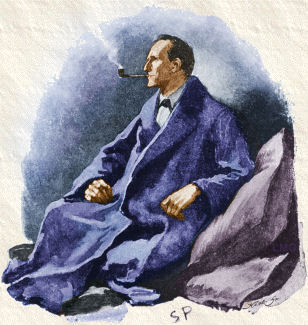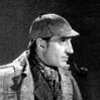Sherlock Holmes

Sherlock Holmes by Sidney Paget
Before there were DNA tests, security cameras or that annoying know-it-all friend who Googles everything, there was Sherlock Holmes.
Armed with nothing but a pipe, a violin, and a talent for making everyone else feel woefully unintelligent, Holmes could deduce your life story from a speck of mud on your shoe. He lived at 221B Baker Street; a flat perpetually filled with pipe smoke, baffled clients, and the exasperated sighs of his loyal roommate, Dr Watson, whose main job was to say, “Good heavens, Holmes! How on earth did you know that?”
Sherlock wasn’t just a detective. He was a Victorian-era supercomputer disguised as a lanky man with a deerstalker hat (which, fun fact, he never actually wore in the original stories — blame the illustrators for that fashion faux pas). Whether solving murders, tracking down missing items, or outwitting arch-nemesis Professor Moriarty, Holmes approached each case like a cryptic crossword — and heaven help you if you were the clue.
So light your pipe (or your scented candle), sit back, and prepare to feel utterly unobservant — it’s time to follow the world’s most brilliant consulting detective into a foggy London where logic reigns, the game is always afoot, and Watson is still trying to keep up.
Sherlock Holmes is one of the most famous fictional detectives from the 19th century and beyond. The stories are said to have inspired Agatha Christie's creation of Hercule Poirot and Miss Marple, along with G K Chesterton's Father Brown.
The following novels and short stories of Holmes were written by Sir Arthur Ignatius Conan Doyle KStJ, DL (22 May 1859 – 7 July 1930):
and finally, a short tale NOT told by Arthur Ignatius Conan Doyle!
Story / Chapter Index
Publication date order
(Index also available in
alphabetical order)
| A Study in Scarlet | A Study in Scarlet is a novel published in Beeton's Christmas Annual, 1887 |
| Part 1 | I | Mr Sherlock Holmes |
| II | The Science of Deduction |
| III | The Lauriston Gardens Mystery | Part 1: Reminiscences of John H Watson MD, late of the Army Medical Department |
| IV | What John Rance had to Tell |
| V | Our Advertisement Brings a Visitor |
| VI | Tobias Gregson Shows what he Can Do |
| VII | Light in the Darkness |
| Part 2 | VIII | On the Great Alkali Plain | Part 2: Country of the Saints |
| IX | The Flower of Utah |
| X | John Ferrier Talks with the Prophet |
| XI | A Flight for Life |
| XII | The Avenging Angels |
| XIII | A Continuation of the Reminiscences of John Watson M.D. |
| XIV | The Conclusion |
| |
| The Sign of Four | The Sign of Four is a novel published in Lippincott's Monthly Magazine, 1890 |
| | I | The Science of Deduction |
| II | The Statement of the Case |
| III | In Quest of a Solution |
| IV | The Story of a Bald-headed Man |
| V | The Tragedy of Pondicherry Lodge |
| VI | Sherlock Holmes Gives a Demonstration |
| VII | The Episode of the Barrel |
| VIII | The Baker Street Irregulars |
| IX | A Break in the Chain |
| X | The End of the Islander |
| XI | The Great Agra Treasure |
| XII | The Strange Story of Johnathan Small |
| |
| The Adventures of Sherlock Holmes | A collection of short stories published in The Strand, 1891–1892 |
| | A Scandal in Bohemia |
| I | Chapter I |
| II | Chapter II |
| III | Chapter III |
| The Red-Headed League |
| A Case of Identity |
| The Boscombe Valley Mystery |
| The Five Orange Pips |
| The Man with the Twisted Lip |
| The Blue Carbuncle |
| The Speckled Band |
| The Engineer's Thumb |
| The Noble Bachelor |
| The Beryl Coronet |
| The Copper Beeches |
| |
| The Memoirs of Sherlock Holmes | A collection of short stories, as further episodes of the Adventures of Sherlock Holmes, published in The Strand, 1892–1893 |
| | Silver Blaze |
| The Yellow Face |
| The Stockbroker's Clerk |
| The 'Gloria Scott' |
| The Musgrave Ritual |
| The Reigate Squires |
| The Crooked Man |
| The Resident Patient |
| The Greek Interpreter |
| The Naval Treaty |
| The Final Problem |
| |
| The Hound of the Baskervilles | A novel serialised in The Strand, 1901–1902 |
| | I | Mr. Sherlock Holmes |
| II | The Curse of the Baskervilles |
| III | The Problem |
| IV | Sir Henry Baskerville |
| V | Three Broken Threads |
| VI | Baskerville Hall |
| VII | The Stapletons of Merripit House |
| VIII | First Report of Doctor Watson |
| IX | Second Report of Doctor Watson |
| X | Extract from Doctor Watson's Diary |
| XI | The Man on the Tor |
| XII | Death on the Moor |
| XIII | Fixing the Nets |
| XIV | The Hound of the Baskervilles |
| XV | A Retrospection |
| |
| The Return of Sherlock Holmes | A collection of short stories published in The Strand, 1903–1904 |
| | The Empty House |
| The Norwood Builder |
| The Dancing Men |
| The Solitary Cyclist |
| The Priory School |
| Black Peter |
| Charles Augustus Milverton |
| The Six Napoleons |
| The Three Students |
| The Golden Pince-Nez |
| The Missing Three-quarter |
| The Abbey Grange |
| The Second Stain |
| |
| His Last Bow | A collection of short stories: Later Reminiscences of Sherlock Holmes, published in 1908–1917) |
| | Preface |
| Wisteria Lodge |
| I | The Singular Experience of Mr. John Scott Eccles |
| II | The Tiger of San Pedro |
| The Cardboard Box |
| The Red Circle |
| I | Part I |
| II | Part II |
| The Bruce-Partington Plans |
| The Dying Detective |
| The Disappearance of Lady Frances Carfax |
| The Devil's Foot |
| His Last Bow |
| |
| The Valley of Fear | The Valley of Fear: A novel serialised in The Strand, 1914–1915 |
| Part 1 | I | The Warning |
| II | Mr Sherlock Holmes Discourses |
| III | The Tragedy of Birlstone | Part 1: The Tragedy of Birlstone |
| IV | Darkness |
| V | The People of the Drama |
| VI | A Dawning Light |
| VII | The Solution |
| Part 2 | VIII | The Man | Part 2: The Scowrers |
| IX | The Bodymaster |
| X | Lodge 341, Vermissa |
| XI | The Valley of Fear |
| XII | The Darkest Hour |
| XIII | Danger |
| XIV | The Trapping of Birdy Edwards |
| Epilogue |
| |
| The Case-Book of Sherlock Holmes | A collection of short stories published in 1921–1927) |
| | Preface |
| The Illustrious Client |
| The Blanched Soldier |
| The Mazarin Stone |
| The Three Gables |
| The Sussex Vampire |
| The Three Garridebs |
| The Problem of Thor Bridge |
| The Creeping Man |
| The Lion's Mane |
| The Veiled Lodger |
| Shoscombe Old Place |
| The Retired Colourman |
Sherlock Holmes and Dr Watson go on a camping trip.
As they lay down for the night, Holmes says: "Watson, look up into the sky and tell me what you see".
Watson:
"I see millions and millions of stars."
Holmes:
"And Watson, as
London's finest doctor, what does that tell you?"
Watson:
"Astronomically, it tells me that
space is infinite, that there are millions of galaxies and potentially
billions of planets.
Theologically, it tells me that God is great and that we are small and insignificant.
Meteorologically, it tells me that we will have a beautiful day tomorrow.
Holmes, as England's finest detective, what does it tell you?"
Holmes:
"Somebody's stolen our tent!"


